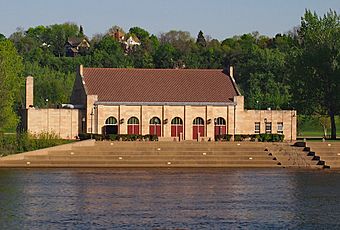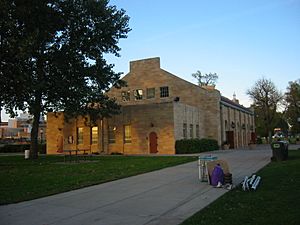Harriet Island Pavilion facts for kids
Quick facts for kids |
|
|
Harriet Island Pavilion
|
|

The Harriet Island Pavilion from across the Mississippi River
|
|
| Location | 200 Dr. Justus Ohage Blvd Saint Paul, Minnesota |
|---|---|
| Built | 1941 |
| Architect | Clarence W. Wigington |
| Architectural style | Moderne |
| NRHP reference No. | 92000821 |
| Added to NRHP | July 10, 1992 |
The Harriet Island Pavilion is a beautiful building in a park on Harriet Island in Saint Paul, Minnesota. It sits right across the Mississippi River from the city's downtown area. Today, it's officially known as the Clarence W. Wigington Pavilion.
This special building was designed by Clarence W. Wigington. He was a very important architect because he was the first African American to be a city architect in the United States. The pavilion was renamed in his honor in 2000 after it was fixed up.
Harriet Island itself is named after Harriet Bishop. She was a teacher who came to Saint Paul in 1847 from Vermont. She started the very first school in this frontier town. She taught all kinds of children, no matter their background. Harriet Bishop was also involved in the temperance movement, which was a group that encouraged people to avoid alcohol.
Contents
History of Harriet Island Park
The park on Harriet Island was created by Dr. Justus Ohage. He was Saint Paul's health officer and gave the land to the city in 1900. His big idea was to make a healthy place for people to enjoy right in the middle of the city.
What the Park Offered
When it first opened, the park had many fun things to do. There was a public bathhouse and a beach where people could swim. It also had playgrounds, picnic areas, and courts for handball and tennis. A bandstand was there for music performances.
Challenges and Changes
The park was very popular at first. However, the Mississippi River became polluted over time. This forced the bathhouse to close in 1919. The city tried several times to make the park popular again. But nothing really worked until the Works Progress Administration (WPA) stepped in.
Building the Pavilion
The WPA was a government program during the Great Depression. It helped put people to work by building public projects. They built the Harriet Island Pavilion between 1941 and 1942. The building's style mixes "Moderne" design, which is a type of Art Deco, with classic building ideas.
Special Building Materials
The stone used to build the pavilion is called Kasota limestone. This stone wasn't new; it was actually recycled! It came from the old Saint Paul City Hall-Ramsey County Courthouse. That building was built in 1889 but was taken down in 1933.




